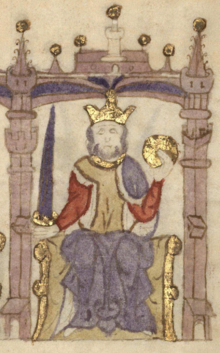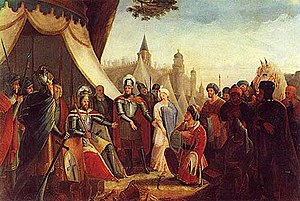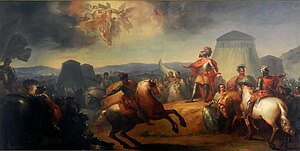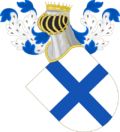Afonso I of Portugal
| Afonso I | |
|---|---|
 | |
| King of Portugal | |
| Reign | 26 July 1139 – 6 December 1185 |
| Acclamation | 26 July 1139 |
| Successor | Sancho I |
| Count of Portugal | |
| Reign | 12 May 1112 – 25 July 1139 |
| Predecessor | Henry |
| Regent | Teresa, Countess of Portugal (1112–1126) |
| Born | 25 July 1109 Guimarães, Portugal |
| Died | 6 December 1185 (aged 76) Coimbra, Kingdom of Portugal |
| Burial | |
| Consort | Mafalda of Savoy |
| Issue among others ... | Urraca, Queen of León Sancho I Theresa, Countess of Flanders |
| House | Burgundy |
| Father | Henry, Count of Portugal |
| Mother | Teresa of León, Countess of Portugal |
| Religion | Roman Catholic |
Afonso I[a] (25 July 1109 – 6 December 1185), nicknamed "the Conqueror" (Portuguese: O Conquistador), "the Founder" ([O Fundador] Error: {{Lang}}: text has italic markup (help)) or "the Great" ([O Grande] Error: {{Lang}}: text has italic markup (help)) by the Portuguese, and El-Bortukali [in Arabic البرتغال] ("the Portuguese") and Ibn-Arrik [in Arabic ابن الرَّنك or ابن الرَنْق] ("son of Henry", "Henriques") by the Moors whom he fought, was the first King of Portugal. He achieved the independence of the southern part of the Kingdom of Galicia, the County of Portugal, from Galicia's overlord, the King of León, in 1139, establishing a new kingdom and doubling its area with the Reconquista, an objective that he pursued until his death, in 1185, after forty-six years of wars against the Moors.
Mother's rule
Afonso I was born in Coimbra, Guimarães or Viseu.[b] He was the son of Henry of Burgundy and Theresa, the natural daughter of King Alfonso VI of León and Castile. The pair reigned jointly as Count and Countess of Portugal until Henry's death, after which Theresa reigned alone.[2] Afonso was slightly more than two years old when his father, Count Henry, died on 22 May 1112 during the siege of Astorga.[3] In an effort to pursue a larger share in the Leonese inheritance, his mother Theresa joined forces with Fernando Pérez de Trava, the most powerful count in Galicia.[2]
The Portuguese nobility disliked the alliance between Galicia and Portugal and rallied around the infant Afonso. The Archbishop of Braga was also concerned with the dominance of Galicia, apprehensive of the ecclesiastical pretensions of his new rival the Galician Archbishop of Santiago de Compostela, Diego Gelmírez, who had claimed an alleged discovery of relics of Saint James in his town, as a way to gain power and riches over the other cathedrals in the Iberian Peninsula. In 1122, Afonso turned fourteen, the adult age in the 12th century. He made himself a knight on his own account in the Cathedral of Zamora, raised an army, and proceeded to take control of his mother's lands.
Sole count
In 1128, near Guimarães, at the Battle of São Mamede Afonso and his supporters overcame troops under his Count Fernando Peres de Trava of Galicia. Afonso exiled his mother to Galicia, and took over rule of the County of Portugal.[2] Thus the possibility of re-incorporating Portugal (up to then known as Southern Galicia) into a Kingdom of Portugal and Galicia as before was eliminated and Afonso became sole ruler following demands for independence from the county's church and nobles. He also vanquished his mother's nephew, Alfonso VII of León, who came to her rescue, and thus freed the country from political dependence on the crown of his cousin of León. On 6 April 1129, Afonso Henriques dictated the writ in which he proclaimed himself Prince of Portugal.
Afonso then turned his arms against the persistent problem of the Moors in the south. His campaigns were successful and, on 25 July 1139, he obtained an overwhelming victory in the Battle of Ourique, and straight after was unanimously proclaimed King of the Portuguese by his soldiers, establishing his equality in rank to the other realms of the Peninsula. The first assembly of the Portuguese Cortes convened at Lamego (wherein he would have been given the crown from the Archbishop of Braga, to confirm his independence) is a 17th-century embellishment of Portuguese history.
Kingship
Independence from Alfonso VII of León's suzerainty, however, was not a thing he just could achieve militarily. The County of Portugal still had to be acknowledged diplomatically by the neighboring lands as a kingdom and, most importantly, by the Roman Catholic Church and the Pope. Afonso wed Mafalda of Savoy, daughter of Amadeus III, Count of Savoy, and sent ambassadors to Rome to negotiate with the Pope. He succeeded in renouncing the suzerainty of his cousin, Alfonso VII of León, becoming instead a vassal of the papacy, as the kings of Sicily and Aragon had done before him. In 1179 the bull Manifestis Probatum accepted the new king as vassal to the pope exclusively.

In Portugal he built several monasteries and convents and bestowed important privileges to religious orders. He is notably the builder of Alcobaça Monastery, to which he called the Cistercian Order of his uncle Bernard of Clairvaux of Burgundy. In 1143, he wrote to Pope Innocent II to declare himself and the kingdom servants of the church, swearing to pursue driving the Moors out of the Iberian Peninsula. Bypassing any king of León, Afonso declared himself the direct liege man of the papacy. Afonso continued to distinguish himself by his exploits against the Moors, from whom he wrested Santarém (see Conquest of Santarém) and Lisbon in 1147 (see Siege of Lisbon).[4] He also conquered an important part of the land south of the Tagus River, although this was lost again to the Moors in the following years.
Meanwhile, King Alfonso VII of León (Afonso's cousin) regarded the independent ruler of Portugal as nothing but a rebel. Conflict between the two was constant and bitter in the following years. Afonso became involved in a war, taking the side of the Aragonese king, an enemy of Castile. To ensure the alliance, his son Sancho was engaged to Dulce, sister of the Count of Barcelona and Infanta of Aragon. Finally after winning the Battle of Valdevez, the Treaty of Zamora (1143) established peace between the cousins and the recognition by the Kingdom of León that Portugal was a sovereign kingdom.
In 1169 the now old Dom Afonso was disabled in an engagement near Badajoz by a fall from his horse, and made prisoner by the soldiers of the king of León Ferdinand II also his son-in-law. Portugal was obliged to surrender as his ransom almost all the conquests Afonso had made in Galicia (north of the Minho River) in the previous years.[4]

In 1179 the privileges and favours given to the Roman Catholic Church were compensated. In the papal bull Manifestis Probatum, Pope Alexander III acknowledged Afonso as king and Portugal as an independent crown with the right to conquer lands from the Moors. With this papal blessing, Portugal was at last secured as a kingdom.
In 1184, in spite of his great age, he still had sufficient energy to relieve his son Sancho, who was besieged in Santarém by the Moors. Afonso died shortly after, on 6 December 1185. The Portuguese revere him as a hero, both on account of his personal character and as the founder of their nation.[4] There are mythical stories that it took 10 men to carry his sword, and that Afonso wanted to engage other monarchs in personal combat, but no one would dare accept his challenge.
Scientific research

In July 2006, the tomb of the king (which is located in the Santa Cruz Monastery in Coimbra) was to be opened for scientific purposes by researchers from the University of Coimbra (Portugal) and the University of Granada (Spain). The opening of the tomb provoked considerable concern among some sectors of Portuguese society and IPPAR – Instituto Português do Património Arquitectónico (Portuguese State Agency for Architectural Patrimony). The government halted the opening, requesting more protocols from the scientific team because of the importance of the king in the nation's formation.[5][6]
Ancestors
These are the known ancestors of Afonso Henriques, going back five generations.
| Family of Afonso I of Portugal | |||||||||||||||||||||||||||||||||||||||||||||||||||||||||||||||||||||||||||||||||||||||||||||||||||||||||||||||||||||||||||||||||||||||||||||||||||||||||||||||||||||||||||||||||||||||||||||||||||||||||||||||||||||||||||||||||||||||||||||||||||||||||||||||||||||||||||||||||||||||||||||||||||||||||||||||||||||||||||||||||||||||||||||||||||||||||||||||||||||||||||||||||||||||||||||||||||||||||||||||||||||||||||||||||||||||||||||||||||||||||||||||||||||||||||||||||||||||||||||||||||||||||||||||||||||||||||||||||||||||||||||||||||||||||||||
|---|---|---|---|---|---|---|---|---|---|---|---|---|---|---|---|---|---|---|---|---|---|---|---|---|---|---|---|---|---|---|---|---|---|---|---|---|---|---|---|---|---|---|---|---|---|---|---|---|---|---|---|---|---|---|---|---|---|---|---|---|---|---|---|---|---|---|---|---|---|---|---|---|---|---|---|---|---|---|---|---|---|---|---|---|---|---|---|---|---|---|---|---|---|---|---|---|---|---|---|---|---|---|---|---|---|---|---|---|---|---|---|---|---|---|---|---|---|---|---|---|---|---|---|---|---|---|---|---|---|---|---|---|---|---|---|---|---|---|---|---|---|---|---|---|---|---|---|---|---|---|---|---|---|---|---|---|---|---|---|---|---|---|---|---|---|---|---|---|---|---|---|---|---|---|---|---|---|---|---|---|---|---|---|---|---|---|---|---|---|---|---|---|---|---|---|---|---|---|---|---|---|---|---|---|---|---|---|---|---|---|---|---|---|---|---|---|---|---|---|---|---|---|---|---|---|---|---|---|---|---|---|---|---|---|---|---|---|---|---|---|---|---|---|---|---|---|---|---|---|---|---|---|---|---|---|---|---|---|---|---|---|---|---|---|---|---|---|---|---|---|---|---|---|---|---|---|---|---|---|---|---|---|---|---|---|---|---|---|---|---|---|---|---|---|---|---|---|---|---|---|---|---|---|---|---|---|---|---|---|---|---|---|---|---|---|---|---|---|---|---|---|---|---|---|---|---|---|---|---|---|---|---|---|---|---|---|---|---|---|---|---|---|---|---|---|---|---|---|---|---|---|---|---|---|---|---|---|---|---|---|---|---|---|---|---|---|---|---|---|---|---|---|---|---|---|---|---|---|---|---|---|---|---|---|---|---|---|---|---|---|---|---|---|---|---|---|---|---|---|---|---|---|---|---|---|---|---|---|---|---|---|---|---|---|---|---|---|---|---|---|---|---|---|---|---|---|---|---|---|---|---|---|---|---|---|---|---|---|---|---|---|---|---|---|---|---|---|---|---|---|---|---|---|---|---|---|---|---|---|---|---|---|---|---|---|---|---|---|---|---|---|---|---|---|---|---|---|---|---|---|---|---|---|---|---|---|---|---|---|---|---|---|---|---|---|---|---|---|---|---|---|---|---|---|---|---|---|---|---|---|---|---|---|---|---|---|---|---|---|---|---|---|---|---|---|---|---|---|---|---|---|---|---|---|---|---|---|---|---|---|---|
| |||||||||||||||||||||||||||||||||||||||||||||||||||||||||||||||||||||||||||||||||||||||||||||||||||||||||||||||||||||||||||||||||||||||||||||||||||||||||||||||||||||||||||||||||||||||||||||||||||||||||||||||||||||||||||||||||||||||||||||||||||||||||||||||||||||||||||||||||||||||||||||||||||||||||||||||||||||||||||||||||||||||||||||||||||||||||||||||||||||||||||||||||||||||||||||||||||||||||||||||||||||||||||||||||||||||||||||||||||||||||||||||||||||||||||||||||||||||||||||||||||||||||||||||||||||||||||||||||||||||||||||||||||||||||||||
Descendants
In 1146,[c] Afonso married Mafalda, daughter of Amadeus III, Count of Savoy and Mahaut of Albon, both appearing together for the first time in May of that year confirming royal charters.[7] They had the following issue:[8]
- Henry (5 March 1147[9][10][11]-1155),[10] named after his paternal grandfather, Henry, Count of Portugal, he died when he was only eight years old.[11] Despite being just a child he represented his father at a council in Toledo at the age of three;[11]
- Urraca (1148[11]–1211[12]), married King Ferdinand II of León and was the mother of King Alfonso IX. The marriage was subsequently annulled in 1171 or 1172 and she retired in Zamora, one of the villas that she had received as part of her arras, and later at the Monastery of Santa María in Wamba, Valladolid where she was buried.;[13]
- Theresa (1151[11] –1218[14]), Countess consort of Flanders due to her marriage to Philip I[15] and Duchess consort of Burgundy through her second marriage to Odo III;[12]
- Mafalda(1153[11][10]-after 1162). In January 1160, her father and Ramón Berenguer IV, Count of Barcelona, negotiated the marriage of Mafalda to Alfonso, future King Alfonso II of Aragon[9][16] who at that time was three or four years old. After the death of Ramón Berenguer IV in the summer of 1162, King Ferdinand II of León convinced his widow, Queen Petronilla, to cancel the infante's wedding plans with Mafalda and for Alfonso to marry instead Sancha, daughter Alfonso VII of León and his second wife Queen Richeza of Poland.[17] Mafalda died in her childhood at an unrecorded date.
- Sancho, the future King Sancho I of Portugal (11 November 1154[10]–26 March 1211). He was baptised with the name of Martin for having been born on the saint's feast day.;[11]
- John (1156–25 August 1164);[18] and
- Sancha (1157–14 February 1166/67), born ten days before the death of her mother, Sancha died before reaching the age of ten.[19][10] on the 14th of February according to the death registry at the Monastery of Santa Cruz (Coimbra) where she was buried.[9]
Before his marriage to Mafalda, King Afonso fathered his first male son with Chamoa Gómez,[10] daughter of Count Gómez Núñez and Elvira Pérez, sister of Fernando and Bermudo Pérez de Traba:[20][21]
- Afonso (1140–1207). Born around 1140,[22] according to recent investigations, he is the same person as the one often called Fernando Afonso who was the alferes-mor of the king and later Grand Master of the Knights Hospitaller. His presence in the court is first recorded in 1159. In 1169 he succeeded as alferes-mor his half-brother, Pedro Pais da Maia, the legitimate son of his mother and Paio Soares da Maia.[23][24]
The extramarital offspring by Elvira Gálter were:
- Urraca.[25] In 1185, her father gave her Avô, stipulating that this villa was to be inherited only by the children that she had with her husband Pedro Afonso de Ribadouro (also known as Pedro Afonso Viegas), grandson of Egas Moniz,[26] which could indicate another previous or subsequent marriage. In 1187, she exchanged with her half-brother, King Sancho, this villa for Aveiro. She died after 1216, the year she made a donation to the Monastery of Tarouca. [27]
- Teresa Afonso, in some genealogies she appears as the daughter of Elvira Gálter,[28] and in others as the daughter of Chamoa Gómez. Her first marriage was with Sancho Nunes de Barbosa with whom she had a daughter, Urraca Sanches, who married Gonçalo Mendes de Sousa, the father of Mendo Gonçalves de Sousa known as "Sousaõ".[29] Her second husband was Fernando Martins Bravo, Lord of Bragança and Chaves, with no issue from this marriage.[29]
King Afonso was also the father of:
- Pedro Afonso (died after 1183), Lord of Arega and Pedrógão, mayor of Abrantes in 1179, alferes of King Afonso I between 1181 and 1183, and Master of the Order of Aviz.[30][31]
See also
- Portugal
- Gallaecia
- Galicia
- History of Portugal
- Timeline of Portuguese history
- Estádio D. Afonso Henriques
Notes
- ^ Or also Affonso (Archaic Portuguese-Galician) or Alphonso (Portuguese-Galician) or Alphonsus (Latin version), sometimes rendered in English as Alphonzo or Alphonse, depending on the Spanish or French influence.
- ^ The actual birthplace is unknown, but Portuguese popular tradition indicates Guimarães as the birth place. Portuguese historian Almeida Fernandes was the first to defend Viseu as the king's birth place, historian Mattoso considers the Viseu hypothesis as likely.[1]
- ^ Although the Annales D. Alfonsi Portugallensium Regis, record that the wedding of Alfonso and Mafalda was celebrated in 1145, it was not until a year later, in May 1146, when they both appear in royal charters. Historian José Mattoso refers to another source, Noticia sobre a Conquista de Santarém (News on the Conquest of Santarém), which states that the city was taken on 15 May 1147, less than a year after their marriage. Since at that time no wedding ceremony could be performed during Lent, Mattoso suggests that the marriage could have taken place in March or April of 1146, possibly on Easter Sunday which fell on 31 March of that year.[7]
References
- ^ Mattoso 2014, p. 27.
- ^ a b c Gerli, E. Michael. Medieval Iberia, Routledge, 2013 ISBN 9781136771613
- ^ Mattoso 2014, p. 34.
- ^ a b c One or more of the preceding sentences incorporates text from a publication now in the public domain: Hannay, David (1911). "Alphonso s.v. Alphonso I.". In Chisholm, Hugh (ed.). Encyclopædia Britannica. Vol. 1 (11th ed.). Cambridge University Press. p. 733.
- ^ IPPAR: direcção nacional diz que não foi consultada sobre abertura do túmulo de D. Afonso Henriques Archived 10 June 2007 at the Wayback Machine, Público, 6 July 2006. Retrieved December 2006 (in Portuguese)
- ^ n:Portuguese Culture Ministry suspends opening of Afonso I's tomb
- ^ a b Mattoso 2014, p. 220.
- ^ Mattoso 2014, pp. 226–227.
- ^ a b c Caetano de Souza 1735, p. 60.
- ^ a b c d e f Rodrigues Oliveira 2010, p. 71.
- ^ a b c d e f g Mattoso 2014, p. 226.
- ^ a b Rodrigues Oliveira 2010, p. 79.
- ^ Arco y Garay 1954, p. 168.
- ^ Rodrigues Oliveira 2010, p. 80.
- ^ Mattoso 2014, pp. 372–373.
- ^ Rodrigues Oliveira 2010, p. 78.
- ^ Mattoso 2014, pp. 287-288 and 290.
- ^ Mattoso 2014, p. 227.
- ^ Mattoso 2014, pp. 227 and 383.
- ^ Calderón Medina 2008, pp. 42, n. 11.
- ^ Mattoso 2014, pp. 98, 228 and 320.
- ^ Mattoso 2014, p. 228.
- ^ Mattoso 2014, pp. 227–229.
- ^ Calderón Medina 2008, pp. 42–43, and notes.
- ^ Caetano de Souza 1735, p. 28 and 64.
- ^ Caetano de Souza 1735, p. 64.
- ^ Sotto Mayor Pizarro 1997, p. 457, n. 9 and 10, Vol. I.
- ^ Caetano de Souza 1735, pp. 28, 63.
- ^ a b Caetano de Souza 1735, p. 63.
- ^ Mattoso 2014, pp. 103, 229 and 388.
- ^ Caetano de Souza 1735, p. 28.
Bibliography
- Arco y Garay, Ricardo del (1954). Sepulcros de la Casa Real de Castilla. Madrid: Instituto Jerónimo Zurita. Consejo Superior de Investigaciones Científicas. OCLC 11366237.
{{cite book}}: Invalid|ref=harv(help) - Baquero Moreno, Humberto (2006). "Portugal e o reino das Astúrias no período de formação". Astúrias e Portugal. Relações históricas e culturais. Actas do Colóquio 5 a 7 de Dezembro de 2005 (in Portuguese). Lisbon: Academia Portuguesa da História. pp. 115–141. ISBN 972-624-164-2.
{{cite book}}: Invalid|ref=harv(help) - Caetano de Souza, Antonio (1735). Historia Genealógica de la Real Casa Portuguesa (PDF) (in Portuguese). Vol. Vol. I. Lisbon: Lisboa Occidental, na oficina de Joseph Antonio da Sylva. ISBN 978-84-8109-908-9.
{{cite book}}:|volume=has extra text (help); Invalid|ref=harv(help) - Calderón Medina, Inés (2004). "La nobleza portuguesa al servicio del rey de León 1157–1187. Pero Pais de Maia y Vasco Fernandes de Soverosa". Actas IV Simposio Internacional de Jóvenes Medievalistas, Lorca 2008 (PDF) (in Spanish). Universidad de Murcia, Sociedad Española de Estudios Medievales, Ayuntamiento de Lorca, et al. pp. 39–50. ISBN 978-84-8371-801-8.
{{cite book}}: Invalid|ref=harv(help) - Freitas do Amaral, Diogo (2000). D. Afonso Henriques (in Portuguese). Lisbon: Bertrand. ISBN 972-25-1157-2.
{{cite book}}: Invalid|ref=harv(help) - Mattoso, José (2014). D. Afonso Henriques (in Portuguese). Lisbon: Temas e Debates. ISBN 978-972-759-911-0.
{{cite book}}: Invalid|ref=harv(help) - Previte-Orton, C.W. (1912). The Early History of the House of Savoy: 1000–1233. Cambridge University Press.
{{cite book}}: Invalid|ref=harv(help) - Rodrigues Oliveira, Ana (2010). Rainhas medievais de Portugal. Dezassete mulheres, duas dinastias, quatro séculos de História (in Portuguese). Lisbon: A esfera dos livros. ISBN 978-989-626-261-7.
{{cite book}}: Invalid|ref=harv(help) - Sánchez Candeira, Alfonso (1999). Castilla y León en el siglo XI, estudio del reinado de Fernando I. Madrid: Real Academia de la Historia. ISBN 978-84-8951241-2.
{{cite book}}: Invalid|ref=harv(help); Unknown parameter|editors=ignored (|editor=suggested) (help) - Sotto Mayor Pizarro, José Augusto (1997). Linhagens Medievais Portuguesas: Genealogias e Estratégias (1279–1325) (in Portuguese). Vol. Vol. I. Oporto: Doctorate thesis, author’s edition.
{{cite book}}:|volume=has extra text (help); Invalid|ref=harv(help) - Torres Sevilla-Quiñones de León, Margarita Cecilia (1999). Linajes nobiliarios de León y Castilla: Siglos IX-XIII (in Spanish). Salamanca: Junta de Castilla y León, Consejería de educación y cultura. ISBN 84-7846-781-5.
{{cite book}}: Invalid|ref=harv(help)
External links
- Use dmy dates from July 2012
- Portuguese Roman Catholics
- Roman Catholic monarchs
- Portuguese monarchs
- Portuguese people of French descent
- House of Burgundy-Portugal
- People of the Reconquista
- 1109 births
- 1185 deaths
- 12th-century Roman Catholics
- Christians of the Second Crusade
- Counts of Portugal (Asturias-León)
- County of Portugal
- 12th-century Portuguese monarchs
- Portuguese revolutionaries


